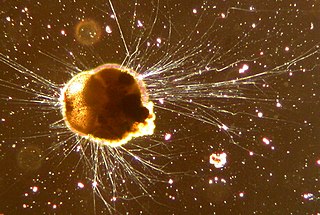| Globigerinoidea | |
|---|---|
 | |
| Rendering of Globigerina bulloides with defensive spines | |
| Scientific classification | |
| (unranked): | SAR |
| Phylum: | Foraminifera |
| Class: | Globothalamea |
| Order: | Rotaliida |
| Suborder: | Globigerinina |
| Superfamily: | Globigerinoidea Carpenter et al., 1862 |
| Families | |
| |
Globigerinoidea is a superfamily of free-living, calcareous, planktonic foraminiferal protists that have lived in the open ocean since the Eocene. It is part of the suborder Globigerinina. [1]

Plankton are the diverse collection of organisms that live in large bodies of water and are unable to swim against a current. The individual organisms constituting plankton are called plankters. They provide a crucial source of food to many large aquatic organisms, such as fish and whales.

Foraminifera are members of a phylum or class of amoeboid protists characterized by streaming granular ectoplasm for catching food and other uses; and commonly an external shell of diverse forms and materials. Tests of chitin are believed to be the most primitive type. Most foraminifera are marine, the majority of which live on or within the seafloor sediment, while a smaller variety float in the water column at various depths. Fewer are known from freshwater or brackish conditions, and some very few (nonaquatic) soil species have been identified through molecular analysis of small subunit ribosomal DNA.
The Eocene Epoch, lasting from 56 to 33.9 million years ago, is a major division of the geologic timescale and the second epoch of the Paleogene Period in the Cenozoic Era. The Eocene spans the time from the end of the Paleocene Epoch to the beginning of the Oligocene Epoch. The start of the Eocene is marked by a brief period in which the concentration of the carbon isotope 13C in the atmosphere was exceptionally low in comparison with the more common isotope 12C. The end is set at a major extinction event called the Grande Coupure or the Eocene–Oligocene extinction event, which may be related to the impact of one or more large bolides in Siberia and in what is now Chesapeake Bay. As with other geologic periods, the strata that define the start and end of the epoch are well identified, though their exact dates are slightly uncertain.
Tests are trochospiral but later chambers may be enveloping. walls are perforate with numerous small pores or fewer larger ones and the surface may be covered with narrow elongate monocrystalline spines. Apertures vary in position from interiomarginal to equatorial and may be relatively large. Secondary apertures along the sutures may also be found. Two families are included, the Globigerinidae and Hastigerinidae.

In biology, a test is the hard shell of some spherical marine animals, notably sea urchins and microorganisms such as testate foraminiferans, radiolarians, and testate amoebae.
The Globigerinacea, sensu Loeblich and Tappan, 1988, is essentially the Globigerinidae of Loeblich and Tappan, 1964, even though reduced in size. The Globigerinidae (L&T 1964) has a longer range, extending from the Late Cretaceous (Maastrichtian) because of the inclusion of Globorotalioides which has been moved to the Globorataliacea as Eoglobiberina. Four subfamilies are included in the Globigerinidae (L&T 1964), the Globigerininae, Sphaeroidinellinae, Capsydracinae, and Obitoidinae. The Globigerinindae is now the Globigerinidae as emended. The Sphaeroidinellinae have been incorporated into the Globigerininae, sensu Loeblich and Tappan 1988. The Capsydracinae and Obitoidinae have been removed to the Globorotaliacea, respectively as the Capsydrancidae and Candeinidae.
The Maastrichtian is, in the ICS geologic timescale, the latest age of the Late Cretaceous epoch or Upper Cretaceous series, the Cretaceous period or system, and of the Mesozoic era or erathem. It spanned the interval from 72.1 to 66 million years ago. The Maastrichtian was preceded by the Campanian and succeeded by the Danian.



